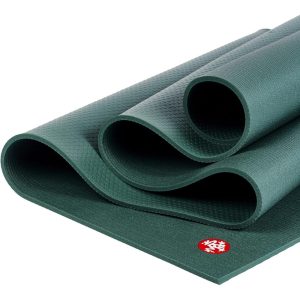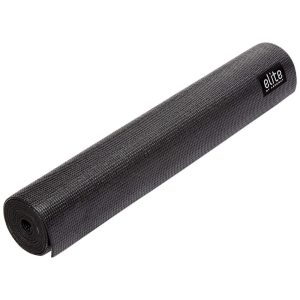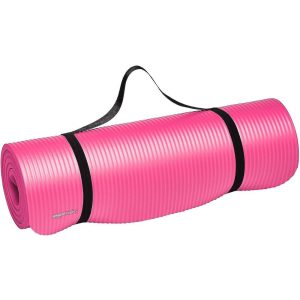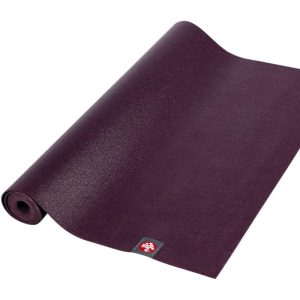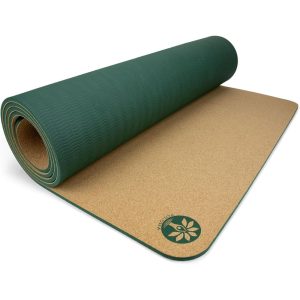Finding the perfect yoga mat can transform your practice, enhancing comfort, stability, and the overall experience. With a myriad of options available, the quest for the best yoga mat can be as challenging as the practice itself. This guide aims to demystify the selection process and present top picks that cater to various needs and preferences, ensuring an ultimate yoga journey.
Whether you’re a seasoned yogi or stepping onto the mat for the first time, choosing a mat that suits your practice style, body type, and ethical preferences is crucial. A mat that aligns with your values and supports your practice can make all the difference in achieving those moments of clarity and calm.
Introduction to Optimal Yoga Practice Mats
Embarking on a yoga practice requires more than just willpower and flexibility—it demands the right foundation. The ideal yoga mat serves as a sacred space where comfort meets durability, allowing practitioners to explore the depths of their yoga journey. It’s not merely about having a cushion between you and the floor; it’s about finding a partner in your practice that supports every pose and transition.
With a spectrum of yoga mats on the market, each promising a unique set of benefits, it’s essential to sift through the marketing noise and select a mat that genuinely elevates your practice. From eco-friendly materials to innovative designs that enhance grip and alignment, the perfect mat could be the key to unlocking the next level in your yoga evolution.
Importance of Choosing the Right Mat
Selecting the appropriate yoga mat is more than a matter of preference—it’s a decision that can impact your practice’s safety and effectiveness. A mat with a textured surface offers the grip needed to maintain poses and transitions securely, while the right amount of cushioning supports the joints without compromising stability. This balance ensures that each session is focused on the practice, not the discomfort or instability that an unsuitable mat can bring.
Expert’s Choice for Best Overall Yoga Mat
When it comes to the best overall yoga mat, the expert’s choice often gravitates towards a balance of quality and performance. One such mat that stands out is designed with both the experienced yoga teacher and the everyday practitioner in mind, offering the resilience needed to withstand rigorous sessions and the comfort to encourage daily use.
1. Manduka PRO
The Manduka PRO is renowned for its textured surface, providing a stable foundation for yogis of all levels. Its unparalleled support and longevity have earned it accolades, becoming a staple in studios and homes alike.
Among the best yoga mats, the Manduka PRO stands out as a firm mat that does not compromise on support or durability. Unlike standard mats, its high-quality material ensures a sticky mat experience without the tackiness. The gaiam performance dry-grip technology incorporated in the mat from lululemon guarantees a steady hold, while the dimensions of 71 x 26 inches cater to a broad range of body types and preferences. The B Mat Everyday, another top contender, offers similar durability and support, proving that a premium yoga experience is not exclusive to luxury brands.
- Exceptional cushioning for joint protection during practice
- Textured surface enables a non-slip experience
- Constructed for longevity with a lifetime warranty
- Easy to clean and maintain
- Optimal balance between grip and the ability to transition smoothly in poses
- Yoga teachers often recommend the Manduka PRO for its dependable performance and the security it provides in any style of practice, facilitating an undistracted focus on breath and movement
- Can become slick when exposed to moisture
- Heavier than other options, which may affect portability
Budget-Friendly Picks Without Compromising Quality
For those mindful of their budgets, there are mats like the mat 5mm that provide an affordable yet high-quality option. This mat, featuring natural rubber, gives the durability and comfort one would expect from more expensive mats like lululemon the mat, without the hefty price tag.
2. Aeromat Elite Yoga Pilates Mat
The Aeromat Elite embodies a blend of affordability and functionality, an ideal option for those seeking value without sacrificing quality.
As one of the best yoga mats for those on a budget, the Aeromat Elite Yoga Pilates Mat proves that a sticky mat doesn’t have to break the bank. Its design mirrors the gaiam performance dry-grip quality found in premium mats, while its 72 x 24 inches dimension accommodates various practices. Though it may not boast the same acclaim as a mat from lululemon or the firm mat assurance of the B Mat Everyday, it stands firmly amongst standard mats as a solid, cost-effective choice.
- Affordable without sacrificing quality
- Offers sufficient grip for stability in various poses
- Comfortable cushioning for joint support
- Durable for regular use
- Versatile for both yoga and Pilates
- May lack the premium feel of more expensive mats
- Grip may not be as advanced as higher-end mats
3. Amazon Basics Yoga Mat
The Amazon Basics Yoga Mat presents a straightforward and accessible option for regular use, ensuring quality doesn’t elude those with a tight budget.
While not as specialized as the B Mat Everyday, the Amazon Basics Yoga Mat offers a reliable surface for daily practice. Its simple design and ease of maintenance make it a practical choice for both beginners and those who carry their mat to and from the studio regularly.
- Made of natural rubber for elasticity and durability
- Features an antimicrobial additive to prevent bacterial growth
- Designed to prevent hands sliding, ensuring stability in poses like downward dog
- Available in darker colors that can conceal marks and stains
- Mat rolls up tightly for convenient storage and portability
- Can be heavy to carry around, weighing 5 lbs
- May require extra cleaning due to open cell technology
Top Performers for Specific Yoga Practices
Selecting a mat tailored to specific yoga practices allows for a more personalized and efficient experience, enhancing both performance and enjoyment.
4. Jade Yoga Harmony Yoga Mat
The Jade Yoga Harmony Yoga Mat delivers the perfect balance of traction and cushion.
For yogis seeking a mat that provides optimal grip, the Jade Yoga Harmony Yoga Mat is an impeccable choice. Its polyurethane top layer ensures a non-slip surface, ideal for any style of yoga. Whether you’re a yoga teacher guiding a class or a practitioner perfecting your asanas, this mat offers the stability needed for a secure practice. Plus, the mat from Lululemon is reversible and absorbs moisture, ensuring comfort throughout the most intense yoga sessions.
- Constructed from tree rubber, ensuring eco-conscious choices
- Excellent grip that aids in maintaining poses without slipping
- A tree planted for every mat sold, contributing to environmental sustainability
- Open-cell structure provides a natural feel and superior traction
- Available in a variety of colors and lengths to suit individual preferences
- Due to the natural materials, may degrade faster than synthetic mats
- Can be relatively heavy, making it less ideal for travel
- Requires regular cleaning to maintain its grip and prevent odor
- Higher cost compared to some synthetic options
Travel-Friendly Yoga Mats for Yogis on the Move
For yogis who live an on-the-go lifestyle, selecting a yoga mat that is travel-friendly is key. A good travel mat needs to be lightweight, adaptable, and durable enough to withstand the rigors of transit while still providing the necessary support for yoga classes anywhere in the world.
5. Manduka EKO Superlite Yoga Travel Mat
The Manduka EKO Superlite Yoga Travel Mat stands out for its portability and grip. Yogis on the move will appreciate the Manduka EKO Superlite Yoga Travel Mat for its lightweight and foldable design.
Weighing just 2 lbs, it’s an effortless addition to any travel bag. With a closed-cell tech construction, this mat resists moisture and maintains the classic Manduka grip, ensuring a reliable practice surface no matter where your travels take you. While it may not replace your everyday mat, it’s an essential travel companion for maintaining a consistent yoga practice.
- Exceptionally lightweight at only 2 pounds, ideal for travel.
- Easily foldable, can fit into small spaces like suitcases and carry-ons.
- Made of natural rubber, 99% latex-free, aligning with eco-conscious values.
- Features closed-cell technology for a hygienic surface that resists moisture.
- Maintains the classic Manduka grip for stability in various poses.
- Due to its thinness, it may not provide enough cushioning for sensitive joints.
- Not intended for daily use over extended periods due to reduced durability.
- May require extra care to maintain its condition when frequently folded
Comfort and Support: Thick Mats for Added Cushioning
Choosing a yoga mat with the right level of thickness can significantly affect your comfort and support during practice, particularly on hard surfaces.
6. BalanceFrom GoYoga All-Purpose Yoga Mat
The GoYoga mat by BalanceFrom provides all-purpose utility. For yogis seeking extra protection for their joints, the BalanceFrom GoYoga All-Purpose Yoga Mat offers thick cushioning without sacrificing stability.
Its high-density foam material ensures a comfortable buffer between the body and the floor, making it an excellent choice for practices that involve prolonged kneeling or lying down. The sticky mat surface also aids in preventing slips, making it a secure option for various yoga styles.
- High-density foam for excellent cushioning
- Non-slip surface enhances safety and performance
- Lightweight and easy to carry with included strap
- Durable material withstands regular use
- Easy to clean and maintain
- May have an initial odor that dissipates over time
- Thicker mats can be less stable for balance-focused poses
- May not be suitable for high-intensity forms of yoga that require firmer support
Design and Style: Yoga Mats With Personality
Yoga mats are not just functional accessories; they can also be an expression of personal style. With a myriad of designs and patterns available, yogis can select a mat that not only meets their functional needs but also reflects their personality and inspires their practice.
7. Gaiam Premium Reversible Lunar Wave Yoga Mat
The Gaiam Premium Reversible Lunar Wave Yoga Mat merges functionality with aesthetic appeal, featuring a unique design that can inspire and uplift your yoga practice. Its reversible nature not only offers versatility but also allows yogis to choose the design that best suits their mood and setting.
Yogis seeking an infusion of creativity into their practice will appreciate the Gaiam Premium Reversible Lunar Wave Yoga Mat. The visually striking patterns are not just for show; they can help to enhance focus and provide a personal, sacred space for practice.
- Reversible design offers two aesthetically pleasing patterns
- Durable and lightweight for easy transportation
- Textured non-slip surface for better grip during poses
- Free from harmful phthalates, making it a healthier choice for you and the environment
- May require frequent cleaning to maintain its vibrant design
- Patterns might be distracting to some practitioners
- Possibility of wear and tear showing more on patterned surfaces
Versatile and Reversible Mats
Versatile and reversible mats offer a combination of convenience and functionality. These mats cater to a variety of workout types and personal preferences, with dual-sided features that can adjust to the user’s needs, whether for a high-intensity session or a gentle stretching routine.
8. Manduka Yoga Mat
The Manduka Yoga Mat is known for its quality and versatility, providing a reliable surface for yogis of all levels.
Manduka mats are celebrated for their dual-sided functionality, which allows yogis to choose the appropriate side for their workout, whether they require more grip or a smoother surface. This feature makes Manduka mats suitable for a diverse range of yoga styles and other fitness routines.
- Reversible sides with different textures to suit various practices
- Constructed with closed-cell technology for easy cleaning
- Durable material that withstands rigorous use
- Lifetime guarantee, ensuring quality and customer satisfaction
- Regular mat wash can help maintain the mat’s longevity and performance, further enhancing the value of the purchase
- May be heavier than other travel-friendly options
- Premium pricing might not be suitable for all budgets
- Can be slippery when new, requiring a break-in period
Sustainable and Eco-Friendly Mat Options
In today’s environmentally conscious society, many yogis are looking for sustainable and eco-friendly yoga mat options. Such mats are designed with both the health of the practitioner and the well-being of the planet in mind, offering a responsible choice for a daily yoga practice.
9. Yoloha Unity Cork
The Yoloha Unity Cork mat stands out as an eco-friendly option that combines sustainability with performance. This mat is particularly well-suited for those with sweaty hands, as its grip and stability improve with moisture, making it a stellar choice for intense sessions.
Embracing an eco-conscious lifestyle extends to the choice of yoga mat, and the Yoloha Unity Cork mat delivers on this front. It provides a grounding experience that connects the practitioner to natural materials while ensuring a confident grip and stability through every pose.
- Excellent wet traction for sweaty hands
- Firm, minimalist foundation for stability
- Made with sustainable materials
- Antimicrobial surface for a cleaner practice
- Easy to clean and maintain
- Higher cost compared to some non-cork options
- Less grip when dry, which may require an adjustment period
- Can be heavy, making it less ideal for travel
- Slow drying time post-cleaning
Our Testing Methodology for Best Yoga Mat Evaluation
Our evaluation of the best yoga mats is thorough and methodical. We assess mats based on a variety of criteria, including durability, comfort, grip, and ease of cleaning. We also consider user feedback and expert opinions to provide well-rounded recommendations that suit the diverse needs of the yoga community.
How We Rated Yoga Mats
Our evaluation process for yoga mats was meticulous and comprehensive. We took into account the diverse needs and preferences of yoga practitioners. Ratings were assigned based on a mat’s performance across various yoga practices. Mats that received 4 to 5 stars excelled in our tests and came highly recommended. Those that earned 4 stars were deemed excellent, with minor shortcomings that did not significantly affect their overall performance. Mats with a 3-star rating were considered average, fulfilling basic requirements but not standing out in the competitive market.
Criteria for Testing and Assessment
When testing yoga mats, we focused on several key aspects to ensure a well-rounded assessment. Durability and comfort were paramount, as well as the mat’s ability to provide a stable surface for those with sweaty hands. We also consulted certified yoga instructors to gain insights into which features were most beneficial during rigorous sessions. Our criteria included the mat’s grip, thickness, material quality, and its suitability for different styles of yoga. The goal was to provide a trustworthy recommendation for every practitioner, regardless of their level of experience or the intensity of their practice.
Comprehensive Guide to Selecting Your Ideal Yoga Mat
Choosing the right yoga mat can significantly enhance your practice. This guide is designed to help you navigate the myriad options available, ensuring that you find a mat that supports your needs while also considering the environmental impact. By understanding the factors that contribute to a high-quality yoga mat, you can make an informed decision that aligns with your values and your practice.
Thickness
One of the first decisions when choosing a yoga mat is its thickness. Thinner mats can provide a stronger connection to the floor, which is essential for stability during standing poses. However, they may offer less cushioning, which can be uncomfortable for certain practices or for those with sensitive joints. The ideal thickness of your yoga mat will depend on your personal preference for cushioning versus stability and how you balance these factors against the types of yoga you practice most frequently.
Material
The material of a yoga mat greatly influences its texture, stickiness, and eco-friendliness. Rubber mats, for instance, are popular for their natural grip and sustainability. They provide a non-slip surface that is crucial for maintaining poses and alignment. Additionally, rubber mats can be more environmentally friendly than their synthetic counterparts, as they are often made from renewable resources and are biodegradable.
Length
For those who enjoy a spacious practice area, the length of the yoga mat is a critical consideration. A mat that is too short can be restrictive, especially when performing elongated poses such as downward-facing dog. It is important to choose a mat that complements your height, allowing full extension of your body without worrying about running out of space. This ensures comfort and freedom of movement throughout your practice.
Cell Type
The cell type of a yoga mat refers to the texture and porosity of its surface. Mats with a textured surface provide additional traction, which can be advantageous for practitioners needing extra grip. Open-cell mats are more absorbent, making them ideal for styles of yoga that induce sweat and moisture. However, they may require more frequent cleaning due to their tendency to absorb oils and liquids.
FAQS
1. What should I consider when choosing a yoga mat thickness?
Consider your joint sensitivity and the type of yoga you practice; thicker mats offer more cushioning, while thinner mats provide better stability.
2. How do I clean my yoga mat?
Use a soft cloth with water and mild soap, or a specialized mat cleaner, and air dry completely before storing.
3. Can I recycle my old yoga mat?
While yoga mats are rarely recycled due to their materials, repurposing or donating them is a sustainable option.
4. What materials are best for yoga mats?
Natural rubber and PVC are common, but eco-friendly materials like jute or cork are also available.
5. How important is the length of a yoga mat?
A mat’s length should accommodate your height and allow for a full range of motion in poses like downward-facing dog.
Care and Maintenance of Your Yoga Mat
Proper care and maintenance of your yoga mat not only extends its lifespan but also ensures a hygienic practice space. Regular cleaning and appropriate storage are essential to keep your mat in optimal condition. Additionally, being mindful of the environmental impact, repurposing or recycling your mat when it’s time for a replacement can help reduce waste and promote sustainability.
Best Practices for Cleaning Your Yoga Mat
To maintain the integrity and longevity of your yoga mat, regular cleaning is recommended. Using a mat cleaner designed for your specific mat type can prevent damage and keep the surface hygienic. Hand washing with cold water and gentle soap can effectively remove dirt and sweat without harming the material. For mats made from natural fibers, this method can preserve their non-slip and reversible qualities, ensuring they remain safe and comfortable for all types of yoga and meditation practices.
Proper Storage Techniques for Yoga Mats
Maintaining the quality of your yoga mat involves more than just the break-in period and daily practice. Proper storage is crucial. To prevent damage and maintain the mat’s structure, it is best to store it rolled or flat, away from direct sunlight, which can degrade the material over time. The Manduka EKO Superlite, for example, with its dimensions of 71 x 24 inches, offers a pragmatic solution for yogis on the go while also being easy to store efficiently at home.
Expert Insights and Final Thoughts on the Best Yoga Mat Choices
After extensive testing and analysis, it is evident that a thick mat can provide extraordinary comfort and support, especially for practitioners with joint sensitivities or those engaging in restorative yoga sessions. The cushioning of a thicker mat absorbs impact and provides a plush surface that can help reduce fatigue and prevent injuries. However, it is crucial to strike a balance between thickness and stability to ensure the mat does not impede balance or proper form during dynamic practices.
While some practitioners may prioritize cushioning, others might value the tactile feedback that thinner mats offer, allowing for a firmer grounding in balance poses. Ultimately, the best yoga mat is one that reflects the individual’s practice style, comfort preferences, and environmental considerations. With the variety of options available, from eco-friendly materials to innovative designs, there is a yoga mat that meets the needs of every yogi.
Final selections should be made with personal practice habits in mind. Whether it’s a mat that caters to intensive hot yoga sessions, one that provides extra length for expansive asanas, or a travel-friendly option for yogis on the move, the perfect mat is out there. By considering the insights from experts and the comprehensive guide provided, practitioners can make an informed choice that will enhance their yoga journey.

